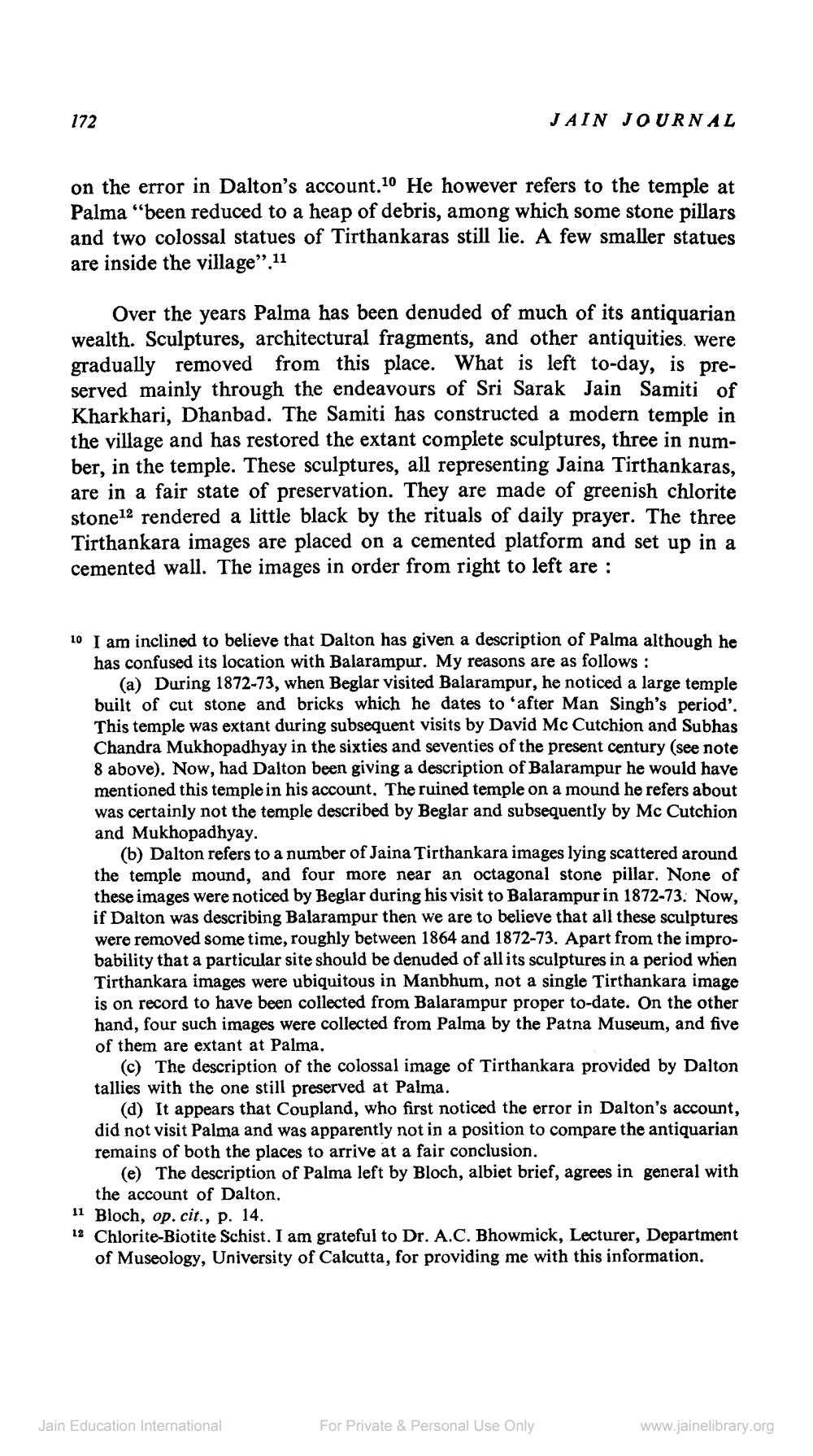Book Title: Jain Journal 1984 04 Author(s): Jain Bhawan Publication Publisher: Jain Bhawan Publication View full book textPage 5
________________ 172 JAIN JOURNAL on the error in Dalton's account.10 He however refers to the temple at Palma "been reduced to a heap of debris, among which some stone pillars and two colossal statues of Tirthankaras still lie. A few smaller statues are inside the village”.11 Over the years Palma has been denuded of much of its antiquarian wealth. Sculptures, architectural fragments, and other antiquities. were gradually removed from this place. What is left to-day, is preserved mainly through the endeavours of Sri Sarak Jain Samiti of Kharkhari, Dhanbad. The Samiti has constructed a modern temple in the village and has restored the extant complete sculptures, three in number, in the temple. These sculptures, all representing Jaina Tirthankaras, are in a fair state of preservation. They are made of greenish chlorite stone12 rendered a little black by the rituals of daily prayer. The three Tirthankara images are placed on a cemented platform and set up in a cemented wall. The images in order from right to left are : 10 I am inclined to believe that Dalton has given a description of Palma although he has confused its location with Balarampur. My reasons are as follows: (a) During 1872-73, when Beglar visited Balarampur, he noticed a large temple built of cut stone and bricks which he dates to 'after Man Singh's period'. This temple was extant during subsequent visits by David Mc Cutchion and Subhas Chandra Mukhopadhyay in the sixties and seventies of the present century (see note 8 above). Now, had Dalton been giving a description of Balarampur he would have mentioned this temple in his account. The ruined temple on a mound he refers about was certainly not the temple described by Beglar and subsequently by Mc Cutchion and Mukhopadhyay. (b) Dalton refers to a number of Jaina Tirthankara images lying scattered around the temple mound, and four more near an octagonal stone pillar. None of these images were noticed by Beglar during his visit to Balarampur in 1872-73. Now, if Dalton was describing Balarampur then we are to believe that all these sculptures were removed some time, roughly between 1864 and 1872-73. Apart from the improbability that a particular site should be denuded of all its sculptures in a period when Tirthankara images were ubiquitous in Manbhum, not a single Tirthankara image is on record to have been collected from Balarampur proper to-date. On the other hand, four such images were collected from Palma by the Patna Museum, and five of them are extant at Palma. (c) The description of the colossal image of Tirthankara provided by Dalton tallies with the one still preserved at Palma. (d) It appears that Coupland, who first noticed the error in Dalton's account, did not visit Palma and was apparently not in a position to compare the antiquarian remains of both the places to arrive at a fair conclusion. (e) The description of Palma left by Bloch, albiet brief, agrees in general with the account of Dalton. 11 Bloch, op. cit., p. 14. 12 Chlorite-Biotite Schist. I am grateful to Dr. A.C. Bhowmick, Lecturer, Department of Museology, University of Calcutta, for providing me with this information. Jain Education International For Private & Personal Use Only www.jainelibrary.orgPage Navigation
1 ... 3 4 5 6 7 8 9 10 11 12 13 14 15 16 17 18 19 20 21 22 23 24 25 26 27 28 29 30 31 32 33 34 35 36 37 38 39 40 41 42 43 44 45 46 47 48 49 50 51 52 ... 67
